काजू में चाय मच्छर कीड़े का प्रबंधन
Cashew (Anacardium occidentale L., Family: Anacardiaceae) is one of the important commercial plantation crops in India. Insect pest infestation is a major production constraint in cashew cultivation. Tea mosquito bugs (TMB)– Helopeltis spp (Miridae: Heteroptera), are most serious insect pest of cashew in India and causes more economic loss to the crop.
There are four species of TMB viz., Helopeltis antonii, H. bradyi, H. theivora and Pachypeltis maesarum (Hemiptera: Miridae) were found to infest in cashew. The mirid bug H. antonii is the dominant species and has been found infesting in all major cashew growing regions of India followed by H.bradyi and H. theivora. It causes damage to an extent of 30-50% yield loss.
Symptoms of damage
- Both nymphs and adults suck the cell sap from tender shoots, leaves, floral branches, developing nuts, fruit peduncle and apples.
- Formation of necrotic lesion on green tender stem of young shoots and inflorescence rachis are the characteristic damage symptoms.
- The lesions on shoots and panicles join together and finally the affected shoot dries up.
- The immature nuts infested by this pest develop characteristic eruptive spots and finally shrivel and fall off.
- Under outbreak conditions, heavily infested trees show scorched appearance, leading to the death of shoots and growing tips.
- Severely affected branches may lead to the secondary infection by fungus (Botrydiplodia theobromae) causing die back disease
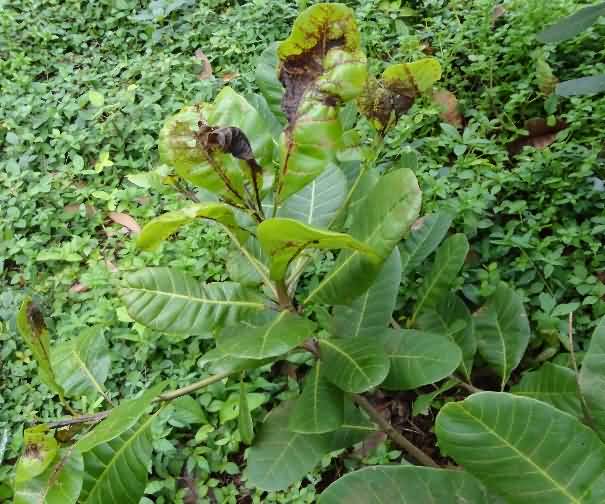
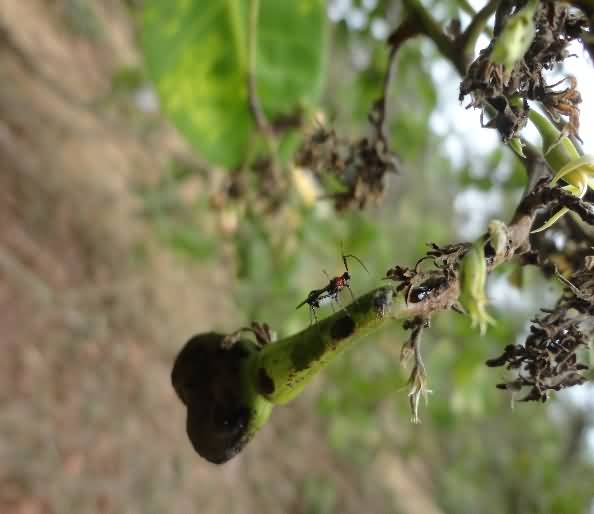
Damaged young leaves Damage on fruit peduncle
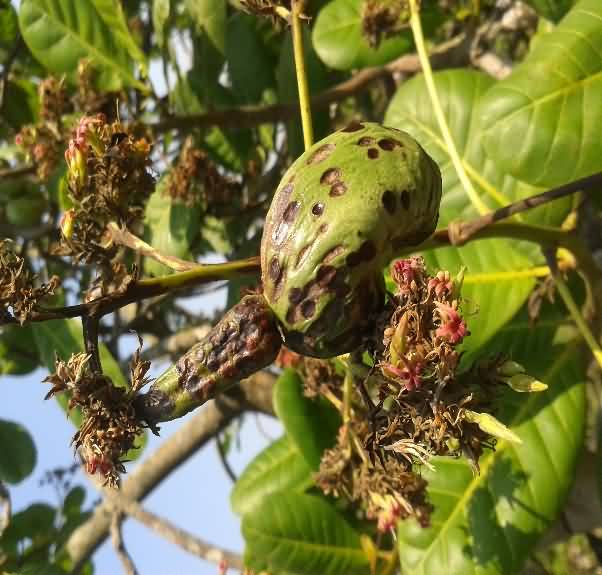
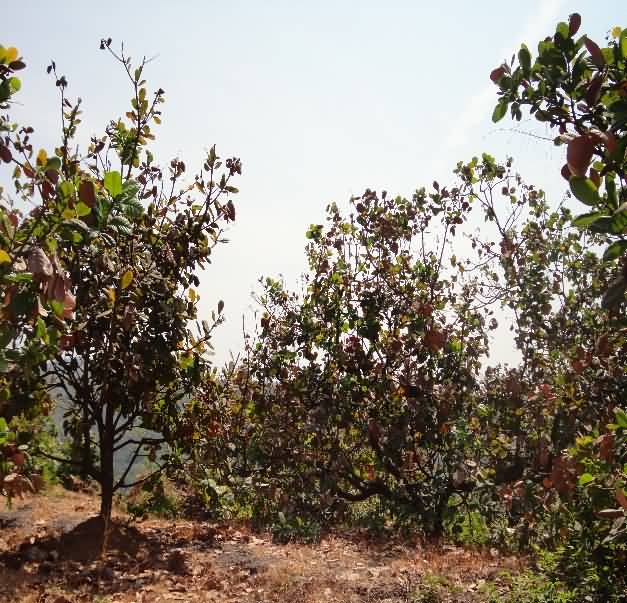
Damaged nut Scorched appearance of affected trees
Identification and biology
- Adult bug of antonii is reddish brown with black head, red thorax and black and white abdomen. The nymph is reddish orange in colour whereas, they are light brown in H. Bradyi and slight greenish in H. theivora.
- All the three species of Helopeltis having thoracic knob which is reddish brown, erect and tapering with the tip knobbed and funnel shaped. The thoracic knob was absent in maesarum.
- Eggs are reniform and creamy white in colour laid in rows deep inside the tender shoots and soft tissues of inflorescence branches.
- A pair of fine thread-like chorionic processes projecting outside indicates the presence of egg inside the tissues.
- Fecundity varies from 94-140 eggs / female. The egg incubation period was 6-7 days.
- Nymph undergoes five instar and becomes adult in 10-15 days. The total life cycle is completed in 17-25 days.

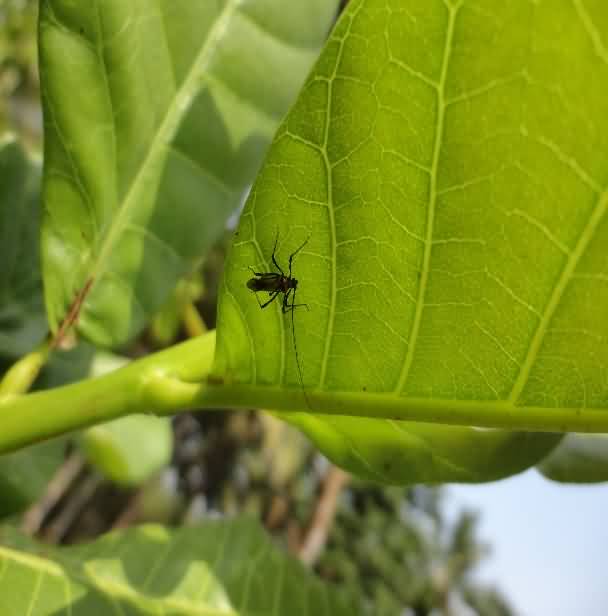
Nymph of TMB Helopeltis antonii
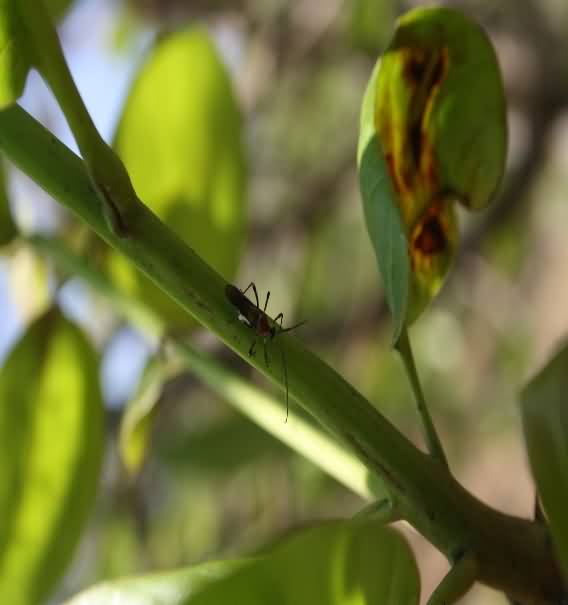
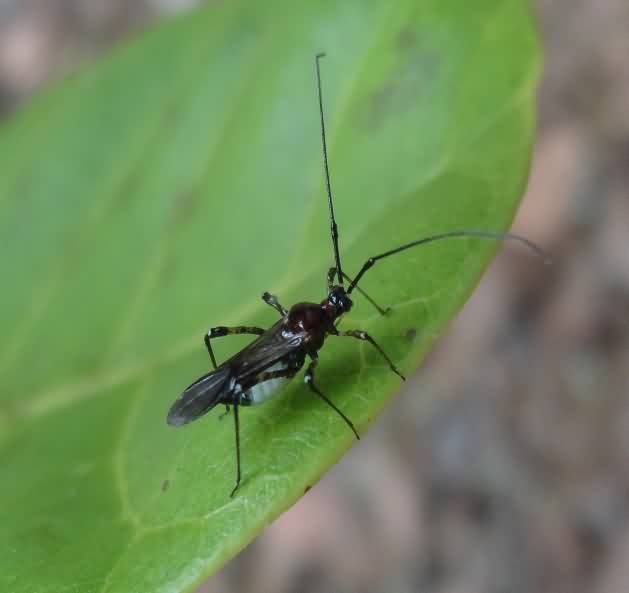
Helopeltis bradyi Helopeltis theivora
Alternate host plants
- The nymphs and adults feed on a variety of host plants such as tea, neem, guava, cocoa, mahogany, cinchona, cotton, apples, grapes, drumstick, black pepper and jamun etc
- It also feeds on numerous weeds like Terminalia paniculata, Getonia floribunda, Macaranga peltata, Chromolaena odorata, Melastoma malabathricum, Meremmia vitifolia, Solanum torvum, Cissus repanda, Strychnos nux vomica, Ixora, Lantana camera, Leea sp.
Seasonal incidence
- Seasonal incidence shows that feeding and multiplication of these bugs will start during the month of November- December because the cashew trees are in their most active growth phase.
- Trees with the new flush and tender inflorescence are highly attractive to the nymphs and adults.
- The pest population reaches its peak, during the month of January-February because these periods the trees are in the full blossom stage.
- Young trees are getting affected more, because of the availability of succulent growth throughout the year.
- Minimum pest activity is noticed during the monsoon period June- September
Integrated Pest Management
Integrated pest management approaches involving monitoring, surveillance, cultural, host plant resistance, chemical and biological control could be adopted to manage these mirid bugs.
- The phytosanitary measure includes removal of alternate host plants in and around the cashew plantations and periodic removal of weeds.
- A proper monitoring of the pest incidence is highly advocated to rationalize the IPM strategies.
- Mid and late season cashew varieties such as Bhaskara are able to escape from the severity of TMB incidence to a certain extent.
- The build of this pest is naturally regulated by egg parasitoids Erythmelus helopeltidis, Telenomus cuspis
- Red ants Oecophylla smaragdina should be encouraged in cashew plantations as it will repel the tea mosquito bug. The population of TMB was significantly lower in plants colonized by red ants.
- Entomopathogenic fungus viz., Beauveria bassiana and Metarizhium anisopliae are found effective against TMB.
- As an ad hoc recommendation, 10% damaged fresh foliar and floral flushes may be considered as the ETL for tea mosquito bugs.
- Need based sprays are recommended during most vulnerable periods of crops such as flushing, flowering and fruiting stage of the crop. Three round of spray schedule is recommended for TMB management.
- 1st Spray: Lamdacyhalothrin at 0.003% (0.6 ml/litre) or imidacloprid 0.6 ml/litre during new flushing stage (November- December).
- 2nd Spray: Acetamiprid (0.5g/litre) or triazophos (0.05% i.e., 1 ml/lit) at flowering stage (Dec- January).
- 3rd Spray: If pest population persist repeat the first spray at the initial fruiting stage (Feb-March)
- Spray well in advance before the insect inflicts damage to the crop. Thorough foliar coverage is a must.
- The same insecticide should not be repeated in the second round. Avoid indiscriminate use of synthetic pyrethroids as it causes flare-up of sucking pests.
- The sprayings should be done before 9 am or after 4 pm in order to save non- target pollinators.
- Whenever die-back disease is associated, spray the canopy with Bordeaux mixture (1%).
Authors:
Dr. Maruthadurai. R,
ICAR-Central Coastal Agricultural Research Institute, Ela, Old Goa, Goa
Email:
